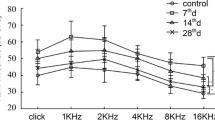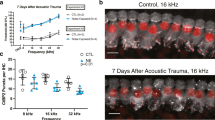Abstract
The ribbon synapses of inner hair cells (IHCs) play an important role in sound encoding and neurotransmitter release. However, it remains unclear whether IHC ribbon synapse plasticity can be interrupted by ototoxic aminoglycoside stimuli. Here, we report that quantitative changes in the number of IHC ribbon synapses and hearing loss occur in response to gentamicin treatment in mice. Using 3D reconstruction, we were able to calculate the number of IHC ribbon synapses after ototoxic gentamicin exposure. Mice were injected intraperitoneally with a low dose of gentamicin (100 mg/kg) once a day for 14 days. Double immunostaining was used to identify IHC ribbon synapses; histopathology and scanning electron microscopy were used to observe the morphology of cochlear hair cells and spiral ganglion neurons (SGNs), the hearing threshold shifts were recorded by auditory brainstem response examinations. Our study shows that the maximal number of IHC ribbon synapses appeared at the 7th day after treatment, followed by a significant reduction after the 7th day regardless of ongoing treatment. Correspondingly, the maximal elevation of hearing threshold was observed at the 7th day after treatment. Meanwhile, additional cochlear components included OHCs, IHCs, and SGNs were unaffected, suggesting that IHC ribbon synapses are more susceptible to ototoxic aminoglycoside stimulation. Our study indicated that quantitative changes in the number of IHC ribbon synapses is critical response to lower dose of ototoxic stimulation, and may contribute to moderate hearing loss. Additionally, our data indcated that ribbon synaptic plasticity may require the quantitative changes to play self-protective role adapted to ototoxic aminoglycoside stimuli.




Similar content being viewed by others
References
Stamataki S, Francis HW, Lehar M, May BJ, Ryugo DK (2006) Synaptic alterations at inner hair cells precede spiral ganglion cell loss in aging C57BL/6J mice. Hear Res 221:104–118
Moser T, Neef A, Khimich D (2006) Mechanisms underlying the temporal precision of sound coding at the inner hair cell ribbon synapse. J Physiol 576:55–62
Sidi S, Busch-Nentwich E, Friedrich R, Schoenberger U, Nicolson T (2004) Gemini encodes a zebrafish L-type calcium channel that localizes at sensory hair cell ribbon synapses. J Neurosci 24:4213–4223
Meyer AC, Frank T, Khimich D et al (2009) Tuning of synapse number, structure and function in the cochlea. Nat Neurosci 12:444–453
Glowatzki E, Fuchs PA (2002) Transmitter release at the hair cell ribbon synapse. Nat Neurosci 5:147–154
Griesinger CB, Richards CD, Ashmore JF (2005) Fast vesicle replenishment allows indefatigable signalling at the first auditory synapse. Nature 435:212–215
Roberts WM, Jacobs RA, Hudspeth AJ (1990) Colocalization of ion channels involved in frequency selectivity and synaptic transmission at presynaptic active zones of hair cells. J Neurosci 10:3664–3684
Tucker T, Fettiplace R (1995) Confocal imaging of calcium microdomains and calcium extrusion in turtle hair cells. Neuron 15:1323–1335
Koschak A, Reimer D, Huber I et al (2001) Alpha 1D (Cav1.3) subunits can form l-type Ca2+ channels activating at negative voltages. J Biol Chem 276:22100–22106
Johnson SL, Marcotti W, Kros CJ (2005) Increase in efficiency and reduction in Ca2+ dependence of exocytosis during development of mouse inner hair cells. J Physiol 563:177–191
Juusola M, French AS, Uusitalo RO, Weckstrom M (1996) Information processing by graded-potential transmission through tonically active synapses. Trends Neurosci 19:292–297
Fuchs M, Scholz M, Sendelbeck A et al (2012) Rod photoreceptor ribbon synapses in DBA/2J mice show progressive age-related structural changes. PLoS One 7:e44645
Liu K, Hu JY, Wang D, Schacher S (2003) Protein synthesis at synapse versus cell body: enhanced but transient expression of long-term facilitation at isolated synapses. J Neurobiol 56:275–286
Ehret G (1979) Quantitative analysis of nerve fibre densities in the cochlea of the house mouse (Mus musculus). J Comp Neurol 183:73–88
Hatada Y, Wu F, Sun ZY, Schacher S, Goldberg DJ. (2000).Presynaptic morphological changes associated with long-term synaptic facilitation are triggered by actin polymerization at preexisting varicositis. J Neurosci 20:RC82.
Francis HW, Rivas A, Lehar M, Ryugo DK (2004) Two types of afferent terminals innervate cochlear inner hair cells in C57BL/6J mice. Brain Res 1016:182–194
Pfannenstiel SC, Praetorius M, Plinkert PK, Brough DE, Staecker H (2009) Bcl-2 gene therapy prevents aminoglycoside-induced degeneration of auditory and vestibular hair cells. Audiol Neurootol 14:254–266
Wu WJ, Sha SH, McLaren JD, Kawamoto K, Raphael Y, Schacht J (2001) Aminoglycoside ototoxicity in adult CBA, C57BL and BALB mice and the Sprague–Dawley rat. Hear Res 158:165–178
Dai CF, Mangiardi D, Cotanche DA, Steyger PS (2006) Uptake of fluorescent gentamicin by vertebrate sensory cells in vivo. Hear Res 213:64–78
Yu L, Jiang XH, Zhou Z et al (2011) A protective mechanism against antibiotic-induced ototoxicity: role of prestin. PLoS One 6:e17322
Liu K, Li S, Jiang X (2009) Quantitative analysis of the ribbon synapse number of cochlear inner hair cells in C57BL/6J mice using the three-dimensional modeling method. Sci China C Life Sci 52:807–812
Bourre JM, Durand G, Erre JP, Aran JM (1999) Changes in auditory brainstem responses in alpha-linolenic acid deficiency as a function of age in rats. Audiology 38:13–18
Sudhof TC (2004) The synaptic vesicle cycle. Annu Rev Neurosci 27:509–547
Roux I, Safieddine S, Nouvian R et al (2006) Otoferlin, defective in a human deafness form, is essential for exocytosis at the auditory ribbon synapse. Cell 127:277–289
Wang Q, Green SH (2011) Functional role of neurotrophin-3 in synapse regeneration by spiral ganglion neurons on inner hair cells after excitotoxic trauma in vitro. J Neurosci 31:7938–7949
Biou V, Bhattacharyya S, Malenka RC (2008) Endocytosis and recycling of AMPA receptors lacking GluR2/3. Proc Natl Acad Sci USA 105:1038–1043
Ma B, Wang L, von Wasielewski R, Lindenmaier W, Dittmar KE (2008) Serial sectioning and three-dimensional reconstruction of mouse Peyer’s patch. Micron 39:967–975
Filippi S, Motyl B, Bandera C (2008) Analysis of existing methods for 3D modelling of femurs starting from two orthogonal images and development of a script for a commercial software package. Comput Methods Programs Biomed 89:76–82
Gruska M, Medalia O, Baumeister W, Leis A (2008) Electron tomography of vitreous sections from cultured mammalian cells. J Struct Biol 161:384–392
Punge A, Rizzoli SO, Jahn R et al (2008) 3D reconstruction of high-resolution STED microscope images. Microsc Res Tech 71:644–650
Ding D, Jiang H, Salvi RJ (2010) Mechanisms of rapid sensory hair-cell death following co-administration of gentamicin and ethacrynic acid. Hear Res 259:16–23
ShuNa L, Zhong R, Ke L (2009) A pattern of otoferlin expression interrupted by gentamicin exposure in ribbon synapse of inner hair cell in C57BL/6J mice. Acta Neurol Belg 109:221–225
Nakagawa T, Yamane H, Shibata S, Nakai Y (1997) Gentamicin ototoxicity induced apoptosis of the vestibular hair cells of guinea pigs. Eur Arch Otorhinolaryngol 254:9–14
Starr A, Picton TW, Sininger Y, Hood LJ, Berlin CI (1996) Auditory neuropathy. Brain 119(Pt 3):741–753
Perletti G, Vral A, Patrosso MC et al (2008) Prevention and modulation of aminoglycoside ototoxicity. Mol Med Report 1:3–13
Komune S, Ide M, Nakano T, Morimitsu T (1987) Effects of kanamycin sulfate on cochlear potentials and potassium ion permeability through the cochlear partitions. ORL J Otorhinolaryngol Relat Spec 49:9–16
Gooi A, Hochman J, Wellman M, Blakley L, Blakley BW (2008) Ototoxic effects of single-dose versus 19-day daily-dose gentamicin. J Otolaryngol Head Neck Surg 37:664–667
Starr A, McPherson D, Patterson J, Don M, Luxford W, Shannon R, Sininger Y, Tonakawa L, Waring M (1991) Absence of both auditory evoked potentials and auditory percepts dependent on timing cues. Brain 114(Pt 3):1157–1180
Acknowledgments
This work was supported by grants from the National Basic Research Program of China (973 Program; 2012CB967900, 2012CB967901, 2011CBA01000), the National Natural Science Foundation of China (NSFC; 30871398, 30730040, 31040038, 81271082). Additionally, this work was also supported by the grants from the China Postdoctoral Science Foundation (201003779, 20100470103), Beijing Natural Science Foundation (5122040), and Fund for Scientific Research of The First Affliliated Hospital of China Medical University (FSFH 1216).
Competing Financial Interest Statements
The authors declare no competing financial interests.
Author information
Authors and Affiliations
Corresponding author
Rights and permissions
About this article
Cite this article
Liu, K., Jiang, X., Shi, C. et al. Cochlear Inner Hair Cell Ribbon Synapse is the Primary Target of Ototoxic Aminoglycoside Stimuli. Mol Neurobiol 48, 647–654 (2013). https://doi.org/10.1007/s12035-013-8454-2
Received:
Accepted:
Published:
Issue Date:
DOI: https://doi.org/10.1007/s12035-013-8454-2




